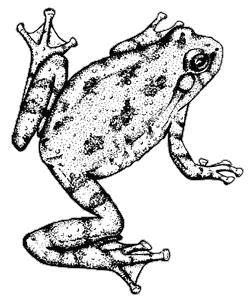Canyon Treefrog
(Hyla arenicolor)
Order: Salientia
Family: Hylidae (treefrogs)
Spanish name: rana
Distinguishing Features
This is a small treefrog with highly variable pattern and color. It grows to 2½ inches (56 mm) with a ground color of cream to brown and irregular bars, blotches, and spots of olive to brown. Its color matches its substrate extremely well. Large adhesive toe pads are present on all 4 feet. Adult males have dusky (darkened) or yellow throats, whereas females have white to cream colored throats (which match the underside).

Range
Barely entering Colorado, this treefrog is mainly found in southern Utah, western New Mexico, southwest Texas, all but western Arizona, and northern Mexico at elevations up to 9800 feet (2990 m).
Habitat
This species is largely restricted to riparian areas in rocky canyons. It is typically found along streams among medium to large boulders from desert to desert grassland and into oak-pine forests. The canyon treefrog can operate at cooler temperatures than many frogs; it avoids cold surface temperatures by retreating underground.
Life History
The canyon treefrog eats insects of various kinds. It breeds in July and August during summer rains as well as in spring. The abrupt, explosive call of males attracts females to breeding sites; males then mount females and spawning may begin. Eggs are laid in a large mass that floats on the surface of the water.
Comments
This is an extremely well camouflaged species that usually does not move until a potential predator is almost on top of it.